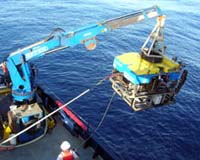| . |  |
. |
New Brunswick, NJ (SPX) May 10, 2011 From a bucket of seawater, scientists have unlocked information that may lead to deeper understanding of organisms as different as coral reefs and human disease. By analyzing genomes of a tiny, single-celled marine animal, they have demonstrated a possible way to address diverse questions such as how diseased cells differ from neighboring healthy cells and what it is about some Antarctic algae that allows them to live in warming waters while other algae die out. Debashish Bhattacharya, professor of ecology, evolution and natural resources in Rutgers' School of Environmental and Biological Sciences, and Ramunas Stepanauskas and Hwan Su Yoon of the Bigelow Laboratory of Ocean Sciences, have published their results in the journal Science. They used sophisticated new technologies to sequence the genomes of individual picobilophytes, tiny microbes first discovered in 2007. At less than 10 micrometers across, they are some of the tiniest marine animals known to science. "If we can peer inside the genome of a single cell and reconstruct its history, we can do that for many cells and figure out their interactions with other cells in the environment," Bhattacharya said. For example, why do different cancer cells from the same tumor grow at different rates? Their genomes might contain the answer, and the answer might lead to more effective treatment strategies. "Our results demonstrate how single cell genomics opens a window into the natural drama that constantly takes place in each drop of seawater - a drama featuring predation, viral infections, and the divergent fate of close relatives," Stepanauskas said. "The outcomes of this drama have profound effects on the lives of larger marine organisms, such as commercially valuable fish." Bhattacharya and Oscar Schofield, professor of marine science, are now working to apply these techniques to Antarctic algae. Some species traditionally found along the Western Antarctic Peninsula are dying off as the water warms, and others, not seen before there, are moving in. If Bhattacharya and Schofield can sequence the genomes of those algae cell by cell, as he and Stepanauskas have done with picobilophytes, they might learn much more about how climate change has affected the ecosystem in that region. Bigelow Laboratory's Single Cell Genomics Center, established by Stepanauskas and his colleagues, has analyzed more than 150,000 individual microbial cells, shedding new light on the invisible majority of our planets biological diversity. When picobilophytes were discovered in 2007, scientists believed they were photosynthetic - that is, that, like green plants, they converted carbon dioxide into food, using energy from sunlight. But these tiny cells have been impossible to culture in the laboratory and this may have been because they were starving, deprived of their natural food sources. For this project, the scientists hauled 50 milliliters (a handful) of seawater out of Boothbay Harbor in Maine, the home of the Bigelow Laboratory. They used a technique called fluorescence activated cell sorting to separate photosynthetic from non-photosynthetic (heterotrophic) cells. They were surprised to find that picobilophytes lacked chlorophyll. They sequenced the genomes of three picobilophytes and were excited to find, in one of them, a new virus, whose circular genome they were able to reconstruct. They were also able to identify and sequence the DNA of creatures the picobilophytes had presumably eaten. For a marine biologist like Bhattacharya, however, the immediate prospects in his own field hold the most promise. "There is a lot of uncharted biodiversity on our planet that we can't get a hold of because we can't cultivate the cells," he said. "Now, if you can reconstruct the nuclear genomes of individual cells in a sample of seawater, you can begin to infer not only the numbers and kinds of organisms that inhabit a particular ecosystem but also the functions of all the genes in their individual genomes."
Share This Article With Planet Earth
Related Links Rutgers University Water News - Science, Technology and Politics
 'Fool's Gold' from the deep is fertilizer for ocean life
'Fool's Gold' from the deep is fertilizer for ocean lifeWashington DC (SPX) May 10, 2011 Similar to humans, the bacteria and tiny plants living in the ocean need iron for energy and growth. But their situation is quite different from ours--for one, they can't turn to natural iron sources like leafy greens or red meat for a pick-me-up. So, from where does their iron come? New research results published in the current issue of the journal Nature Geoscience point to a sourc ... read more |
|
| The content herein, unless otherwise known to be public domain, are Copyright 1995-2010 - SpaceDaily. AFP and UPI Wire Stories are copyright Agence France-Presse and United Press International. ESA Portal Reports are copyright European Space Agency. All NASA sourced material is public domain. Additional copyrights may apply in whole or part to other bona fide parties. Advertising does not imply endorsement,agreement or approval of any opinions, statements or information provided by SpaceDaily on any Web page published or hosted by SpaceDaily. Privacy Statement |